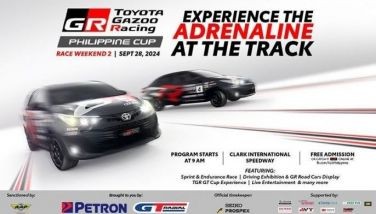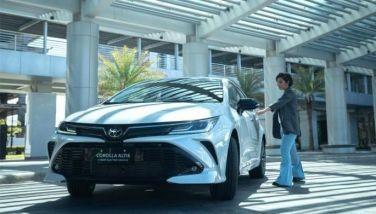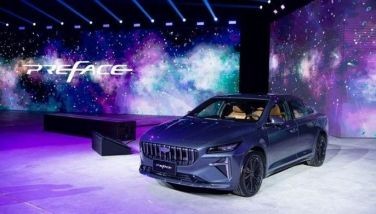Driving to the future: Are hydrogen cars the answer?
January 18, 2006 | 12:00am
Experts worldwide think hydrogen will replace gasoline, diesel and natural gas as the main fuel for cars, buses and trucks over the next few decades. Car companies are pouring billions of dollars in research and development. And who can question them, when the advantages of hydrogen are staggeringly enormous in their significance: no more smog-forming exhaust gases, no more carbon dioxide emissions that contribute to global warming, no more worries about diminishing oil supplies and rising prices, among others.
But some tricky questions need to be answered before mass-produced hydrogen cars start rolling down your street: Where will the hydrogen come from? How will motorists fill up? How will cars store the fuel? Then there’s the question of how to tap the energy in the fuel to maximize performance.
Two kinds of engines can use hydrogen as a fuel — those that have an internal combustion engine converted to use hydrogen and those that are made up of a stack of fuel cells.
Internal combustion engines need no introduction. These are precisely the type of engines purring under the hoods of cars ranging from Kia Picantos to Michael Schmaucher’s Ferrari F1 car. These engines can be converted to run on a variety of fuels, including hydrogen with minimal modifications. When hydrogen burns, the only by-product is water — not the polluting cocktail given off by burning petroleum fuels.
BMW is the leading proponent of internal combustion-based hydrogen technology, having successfully adapted it to numerous R&D fleets from its production car line. To underscore the levels of experience they have with the technology, the Bavarians created the BMW H2R, a concept race car powered by a hydrogen-fed 286-hp 6.0-liter V12 derived from BMW’s 760iL luxury sedan. The H2R can rocket from 0 to 100 kph in six seconds and hurtle on to a top speed of 300 kph.
Other carmakers, however, think that fuel cells powering an electric motor offer a more practical alternative. Unlike batteries, which store electricity, fuel cells create electricity as they go. Recent developments in technology have greatly increased the amount of power that a stack of cells — small enough to fit under a car’s hood — can provide. This has opened up the prospect of non-polluting electric cars with the performance we expect from gasoline-powered vehicles.
In fuel cell engines, the hydrogen fuel reacts with oxygen from the air to produce water (which comes out of the tailpipe) and electricity (which powers the car) — the reverse of the familiar electrolysis process that releases oxygen and hydrogen from water. Basically, water molecules are split into their hydrogen and oxygen constituents by electrolysis, or by shocking them with an electric current. Then, after the hydrogen makes a trip through a fuel cell, it recombines with oxygen in the air and reverts back to water.
The big advantage of a fuel cell engine over an internal combustion engine running on hydrogen is its greater efficiency. The same amount of hydrogen will take a fuel cell car at least twice as far as one with a converted internal combustion engine.
But as promising as hydrogen-powered cars are, there are numerous downsides, many of which are substantial. One of these is that it is difficult to store. This is because at normal temperatures, hydrogen is a gas. The hydrogen must be packed tightly into a car’s tank, otherwise a filling stop will be needed every few kilometers.
The obvious solution is to greatly compress the hydrogen, or liquefy it at temperatures approaching minus 235oC. However, large amounts of energy are needed for this — an estimated 20 to 40 percent of the energy content of the fuel. Also, tanks designed to hold hydrogen at extremely high pressures, or at temperatures approaching absolute zero, are heavy and expensive. Any onboard cryogenic system would be that.
And then there’s an even tougher problem: Where would drivers get the fuel? Fewer than 100 filling stations in the whole world now pump hydrogen. So it could be a couple of decades before fuel-cell cars become popular enough to make a dent either in pollution or in fossil fuel consumption.
BMW’s short-term answer is having a bi-fuel engine. The German firm’s hydrogen engines can run on either hydrogen or gasoline with a switch of a button. For daily trips around town, one can drive on hydrogen to save gasoline and minimize urban pollution. If a trip on hydrogen goes beyond that fuel’s 345-km range, the car would automatically switch over to gasoline, easily doubling that range.
The downside to burning hydrogen in a combustion engine is that it produces some pollution — a small amount of nitrogen oxides (NOx). But BMW asserts that its out-the-tailpipe NOx levels will be well below even California’s strict Super Ultra Low Emission Vehicle (SULEV) standard.
But that’s not all the problems. If the vehicle isn’t started up for three or four days, the liquid hydrogen will begin to boil, and hydrogen gas will escape through a vent. That, however, isn’t as dangerous as it is wasteful, because hydrogen is less dangerous than gasoline. It disperses quickly, so even when a container leaks, explosions are next to impossible.
So when will zippy bi-fuel BMWs show up at dealers? It’s hard to tell, but BMW plans to put small numbers of them on the road, probably in Europe, within two or three years and in the U.S. around 2010.
By then, there could be multiple hydrogen filling stations serving major cities. Already, the German government is sponsoring development of filling stations with their own hydrogen generators. That way, the lack of hydrogen pipelines and delivery trucks won’t hold back the early transition away from gasoline and diesel to hydrogen cars — and to the ultimate goal of pollution-free fuel cells.
Refueling stations with electrolyzers have been built in Berlin, Hamburg, and Munich. And others have been installed as part of the Clean Urban Transport for Europe program in Amsterdam, Barcelona, Reykjavik and Stockholm.
Hydrogen filling stations are also getting sprinkled across the U.S. Its Energy Dept. announced early last year that it would spend $190 million over five years if the industry contributed a similar sum to build hydrogen-and-gasoline stations and other infrastructure projects. Shell and General Motors responded right away, opening a new hydrogen station in Washington in the middle of 2005.
In California, the DoE has awarded a contract for the construction of two dozen stations to a team led by Air Products & Chemicals Inc., which has already built 30 hydrogen stations around the globe and is the No. 1 producer of hydrogen.
California Governor Arnold Schwarzenegger even called for a "hydrogen highway network" by 2010, envisioning at least 150 fuel stops at regular intervals along major highways. The California Fuel Cell Partnership, composed mainly of transportation agencies and carmakers, has so far built 13 hydrogen stations, with more on the drawing board.
As far as Asia is concerned, rapid technology transfer, government support (though not in all Asian countries) and the fact that many of the carmakers involved with hydrogen technology are themselves Asian should fast-track the development and adoption of this technology.
Ultimately, time will tell when millions of motorists will be zipping along in near-silent cars, their tailpipes spewing out nothing more harmful than good old water.
BrandSpace Articles
<
>
- Latest
Latest
Latest
September 30, 2024 - 4:26pm
By EC Toledo | September 30, 2024 - 4:26pm
September 26, 2024 - 3:30pm
September 26, 2024 - 3:30pm
August 16, 2024 - 11:00am
By Euden Valdez | August 16, 2024 - 11:00am
Recommended





























